7 December 2020
The release of the amended Draft Phase 3 Planning and Design Code and accompanying Phase Three (Urban Areas) Planning and Design Code Amendment Summary of Post-Consultation Amendments November 2020 report allows all councils one final opportunity to review and ‘road-test’ the Code before its final implementation at an as-yet unconfirmed date in 2021.
Continuing our support for councils during the implementation of the PDI Act, Kelledy Jones Lawyers, together with Development Answers have reviewed these documents and offer a number of observations and comments for consideration during the preparation of council submissions.
Our earlier Papers in this series can be found here and here.
We encourage all councils to carefully consider and review these documents as the Code amendments will apply across the State and there are a number of new Zones and policies which are intended to address and/or clarify Phase 2 policy anomalies and/or omissions.
Rural Zone
The Rural Zone will replace the current Primary Production Zones and similar Zones in council Development Plans.
In reviewing the Rural Zone, we note that it contains more than 100 pages – most of these pages are the Development Classification Tables.
In addition, the Zone is subject to several Overlays and TNVs which must be carefully considered in determining the nature of a proposed development and in relevant assessments. It is imperative that all Zone boundaries, Overlays and TNVs in all council areas are carefully reviewed.
Specific observations include:
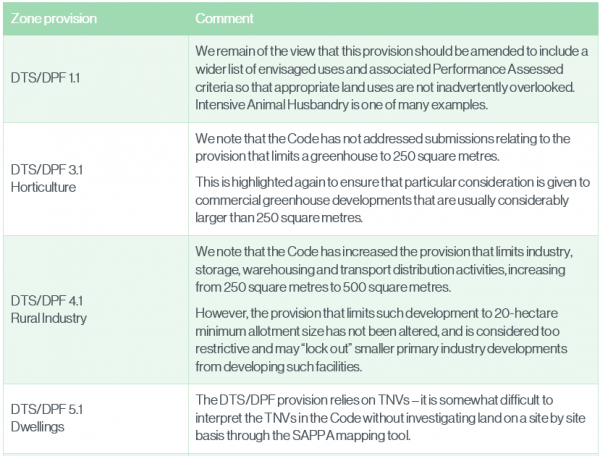
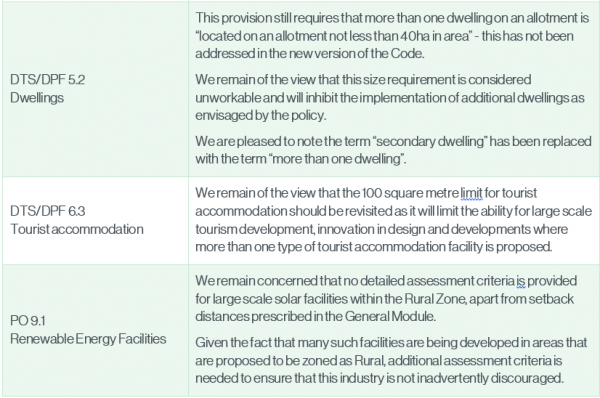
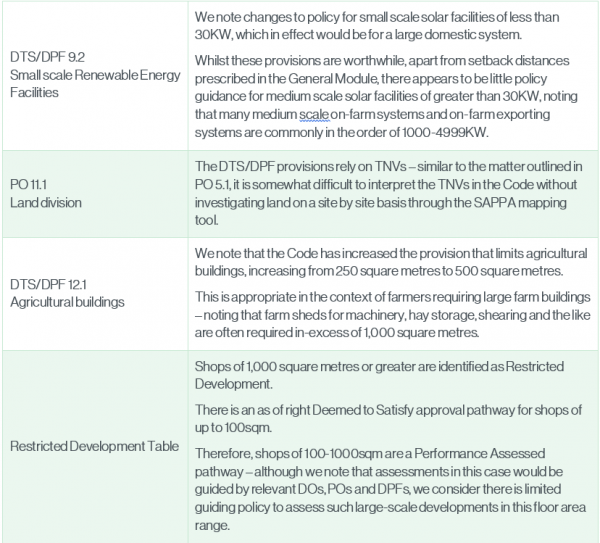
PO 1.1 and its DTS/DPF 1.1 of the dwelling excision overlay are contradictory – the PO allows for the creation of an additional lot in certain cases, whereas the DTS/DPF says ‘no additional allotments are created’’ – this needs simple refinement as the overlay is specifically intended to allow additional lots in the circumstances.
We are pleased to note that it is intended to exclude Frost Fans from the definition of Agricultural Building, thereby averting the potential for an as-of-right, Deemed to Satisfy approval for development that needs careful consideration of noise and visual impacts – when reading Part 7 of the Code you will need to refer to the sixth heading ‘Land Use Definitions Table’ and not the first heading ‘Land Use Terms’. Although we support a definition change, there is now the need for detailed policy for Performance Assessed applications, for Frost Fans.
We compliment the changes to this Zone which now require less restrictions on public notification in rural areas and for the exemption for placing a sign on the land in designated zones.
Adelaide Country Zone
The Code has introduced the Adelaide Country Zone, as shown below.
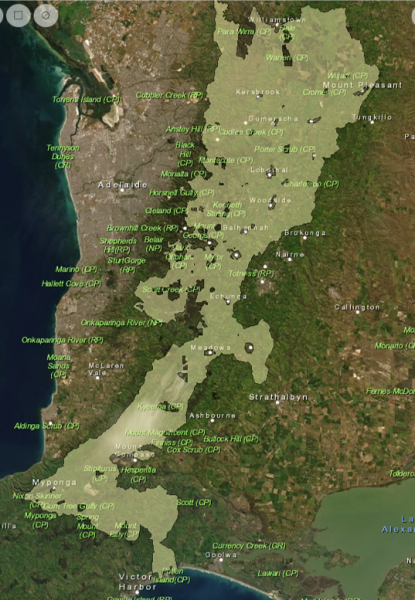
Source:- SAPPA Code mapping – Adelaide Country Zone in light green
In response to various submissions the proposed new name Adelaide Country Zone seeks to apply a new naming convention that better reflects the intent of the zone.
There may be differing views on the name of the zone with the word “Adelaide” and “Country” in the same zone name, but it is the zone policy that is more important – the zone affects key iconic areas such of the Mount Lofty Ranges, southern Barossa Valley region and the Fleurieu Peninsula. Various rural areas of the Barossa Valley are now within the Adelaide Country Zone, the Rural Zone and the Rural Horticulture Zone. The former Peri-Urban Zone no longer applies.
Specific observations include:
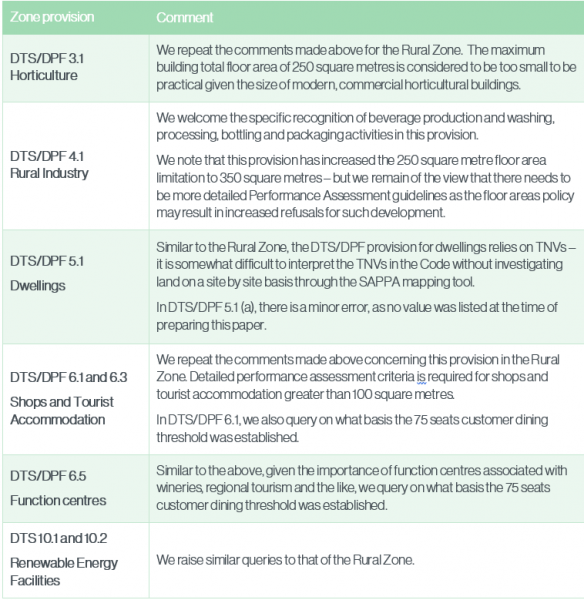
General comments
We note that it is difficult to reconcile changes between the 2019 consultation version of the Code and the current November 2020 version – and more so for the general public.
Although we understand the Rules of Interpretation for the Code, we continue to query the use of Deemed to Satisfy criteria (via use of the same Designated Performance Feature – DPF) for Performance Assessment purposes within zones. This may lead to varying levels of interpretation and uncertainly across the sector.
The Notification Table in most of the zones needs minor redrafting. That is, we are advised the separate entries in the table are to be read in isolation of each other, yet each entry says ‘subject to 1…..’ – if this is the case the ‘subject to 1…..’ should be deleted. Either way, the drafting should be altered to provide for easier interpretation and to avoid potential for legal challenges. We note that the State Planning Commission is aware of this and plans to address the matter.
For further information regarding the draft Code, please contact:
Victoria Shute: vshute@kelledyjones.com.au
David Altmann: answers@developmentanswers.com.au

LINKS TO PAST PAPERS:
| Paper Title |
Date |
| LG Alert: De-coding Phase 3 of the Planning and Design Code – Paper 2: Shops, Restaurants and Other Commercial Uses |
November 2020 |
| LG Alert: De-coding Phase 3 of the Planning and Design Code – Paper 1: Residential Development |
November 2020 |
| LG Alert: Planning Reform Update – Public Consultation, Contributory Items and More |
November 2020 |
| LG Alert: Are You Ready for the Planning and Design Code? |
July 2020 |
| LG Alert: Proclamations and more legislative changes to our new planning system |
June 2020 |
| LG Alert: What We Have Heard Report – Phase Three of the Planning and Design Code (Urban Areas) |
June 2020 |
| LG Alert: Planning and Design Code – Amendment for Phase 2 (Rural Areas) |
June 2020 |
| LG Alert: Draft Planning and Design Code – Update Report from the State Planning Commission on Phase Two of the Planning and Design Code (Rural Areas) |
April 2020 |
| LG Alert: Balancing COVID-19 pandemic measures against the administration of the Development Act 1993 and the Planning, Development and Infrastructure Act 2016 |
March 2020 |
| LG Alert: BREAKING NEWS: Pushing back the Planning and Design Code |
February 2020 |
| LG Alert: an Update on the State Planning Commission’s Draft Planning and Design Code: Update Report |
January 2020 |
| LG Alert: Draft Planning and Design Code – Part Eight |
December 2019 |
| LG Alert: Draft Planning and Design Code – Part Seven |
December 2019 |
| LG Alert: Draft Planning and Design Code – Part Six |
November 2019 |
| LG Alert: Draft Planning and Design Code – Part Five |
November 2019 |
| LG Alert: Draft Planning and Design Code – Part Four |
November 2019 |
| LG Alert: Draft Planning and Design Code – Part Three |
October 2019 |
| LG Alert: Draft Planning and Design Code – Part Two |
October 2019 |
| LG Alert: Draft Planning and Design Code – Part One |
October 2019 |
| LG Alert; Renewing renewable energy policy – what is proposed to change in the Planning and Design Code? |
July 2019 |
| LG Alert: Swimming pool safety and the PDI Act |
July 2019 |
| LG Leader: The Planning, Development and Infrastructure (General) Regulations 2017 are now complete and our new development system is largely revealed – what does this all mean? |
July 2019 |
| LG Leader: So what has DPTI heard on the draft Planning, Development and Infrastructure (General) (Development Assessment) Variation Regulations 2019? |
June 2019 |
| LG Leader: Planning, Development and Infrastructure Act 2016 – Planning Reform Well Underway |
March 2019 |
| South Australia’s Planning Reforms: the transition to a new planning system in full swing (2019) 18(1) LGOVR 4 |
January 2019 |
| LG Leader: Accredited Professionals and Panels – a view to the future |
June 2018 |
| LG Leader: PDI Accreditation Scheme – do you need to be Accredited? |
March 2018 |
| New Council Assessment Panels in South Australia – an overview (2018) 17(1) LGOVR 7 |
February 2018 |
| LG Leader: Recent developments in development law |
July 2017 |
| (Planning) systems are go! South Australia’s transition to a new planning system is underway (2017) 16(5) LGOVR 91 |
July 2017 |
| LG Leader: The Existing Activity Centres Policy Review DPA – “streamlining” the planning system ahead of the PDI Act implementation process |
September 2016 |
| LG Alert: Everyone is talking about it – but are you across the detail? Our detailed overview of the proposed amendments to and implementation of the Planning, Development and Infrastructure Act 2016 |
September 2016 |
| LG Alert: Update to the 30 Year Plan for Greater Adelaide – How Will It Affect the New Planning System? |
August 2016 |
| Planning, Development and Infrastructure Act 2016 – South Australia’s new planning system has passed into law. What does the new Act contain and what will happen next? (2016) 15(4) LGOVR 264 |
June 2016 |
| A look into the future – the Planning, Development and Infrastructure Bill 2015 outlines South Australia’s new planning system (2016) 15(1) LGOVR 204 |
March 2016 |
| LG Alert: PDI Bill Update – New infrastructure scheme proposed |
February 2016 |
| LG Alert: PDI Bill Update |
November 2015 |
| LG Alert: Planning, Development and Infrastructure Bill 2015 – Frequently Asked Questions |
October 2015 |
| LG Alert: Amendments to the PDI Bill |
September 2015 |
| LG Leader: Transitioning to a new planning system – a longer-term process |
September 2015 |
| LG Leader: Which comes first, the land division or the building? Parliament will soon resolve this question once and for all. |
March 2015 |
| LG Alert: Planning Reform Update – key points from the Government’s response to the final report and recommendations of the Expert Panel on Planning Reform |
March 2015 |
| LG Alert: Back to the Future? The Expert Panel’s final report |
December 2014 |
| LG Leader: The Future of Development Assessment Panels |
June 2014 |
| LG Leader: Our Planning System – a central issue in the 2014 State Election |
March 2014 |
| LG Leader: What We Have Heard – South Australia’s Expert Panel on Planning Reform delivered its first report |
December 2013 |
| Planning law reform builds momentum in South Australia (2013) 11(8) LGOVR 126 |
July 2013 |
| LG Leader: Planning law reform gathers momentum – Parliament wrap-up |
May 2013 |
| LG Leader: Government Announces Comprehensive Review of Planning System – the Planning Improvement Project |
March 2013 |







